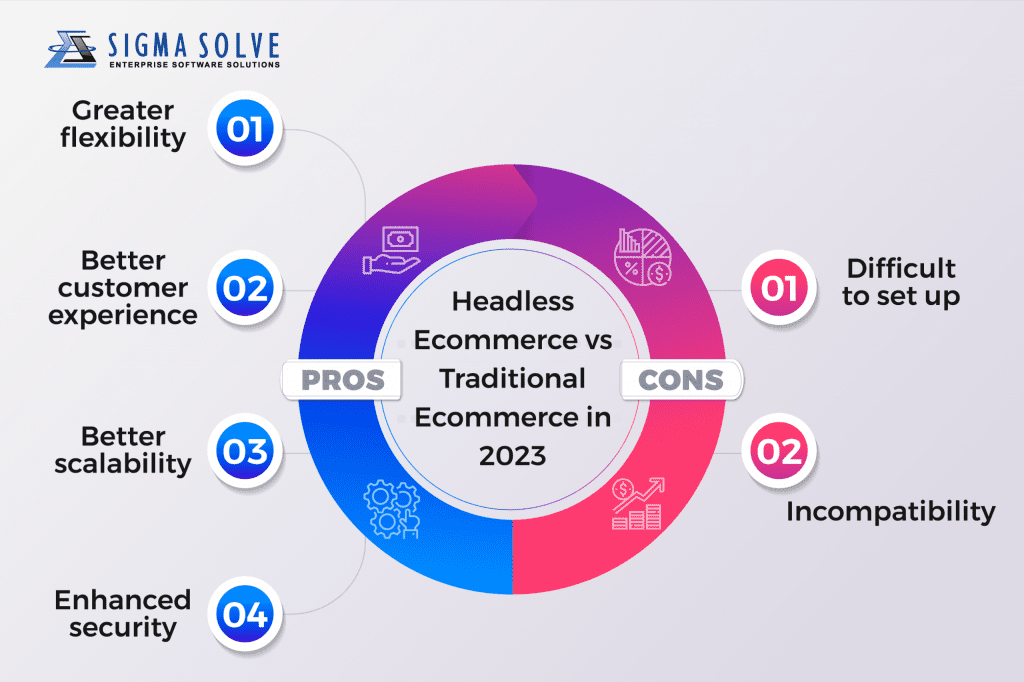There’s no denying that e-commerce is on the rise. In recent years, global ecommerce sales reached outstanding numbers, and they are projected to go even higher. The sky is no longer the limit! This rapid growth is due in part to the increasing popularity of headless ecommerce. But what is headless ecommerce? How does it compare to traditional ecommerce? Which type of ecommerce will come out on top in 2023?
In this article, we provide you with in-depth information on what headless ecommerce is and the various benefits you can derive from it. We also compare it to traditional e-commerce and make a projection on which of the two will come out on top in 2023.
What is Headless Ecommerce?
Headless ecommerce is an approach to ecommerce that decouples the front end from the backend. This means that the front end, or client side, of the ecommerce website is not dependent on the back end or server side.
It is a decoupled architecture that is a relatively new approach. It continues to gain massive popularity because of the numerous benefits that can be obtained by using it.
What is Traditional Ecommerce?
Traditional e-commerce refers to the traditional buying and selling of goods and services online using a centralized platform, typically a website. This type of e-commerce has been around since the early days of the Internet and is still the most common way for businesses to sell online.
Unlike headless ecommerce, traditional ecommerce approaches couple the front end and back end of the site together. It can lead to decreased flexibility and poorer performance, as well as scalability issues.
Factors that Determine eCommerce Development Services
Customization:
Needs change over time, and businesses are required to add the latest features. Therefore, a platform should allow complete customization of the eCommerce store.
Resources:
Businesses must evaluate their business needs and the complexities eCommerce development may involve to determine the types of skilled developers they need for architecture.
Budget:
Financial Investment in digital commerce development is the most critical aspect of determining the architecture. Businesses must also consider long-term benefits.
Scalability:
What lies in the future is an essential determinant in ascertaining the eCommerce development architecture. Scalability is a must for eCommerce as the business is bound to grow.
Time to Market:
The speed of the development process is critical in covering the market, and therefore, it is essential to select the platform that helps businesses launch e-commerce stores quickly.
Integration:
Evaluate whether your eCommerce store requires third-party integration or another CMS. Integration is critical to extending the functionalities’ potential.
Content Management:
Content delivery is an ongoing process for an eCommerce platform. Omnichannel advanced content delivery determines the development architecture.
Maintenance:
It is vital to know if the in-house team can handle the complexities and debug the system as and when required or if offshore support is required due to platform constraints.
Performance:
Faster loading, longer uptime, heavy traffic, etc., are essential factors in evaluating performance. An eCom store shouldn’t buckle under pressure from a high load.
Head-to-Head Comparison:
Feature | Headless eCommerce | Traditional eCommerce |
Frontend | It is flexible and disjoined from frontend | It is firmly coupled with the frontend and is inflexible. |
Backend | The architecture here is API-driven | It has a monolithic architecture |
Customization | There are no limits to the customization | The platform constraints limit customization |
Speed | It provides a faster page loading speed | The load time can be slow and slower with plug-ins |
Scalability | It makes the eCommerce store highly scalable | Making the eCommerce store scalable could be a challenge |
Omnichannel | It is self-sufficient with native support | It requires external omnichannel integration |
Content Management | Content management is a breeze as it can use any CMS | Users required to use only platform-offered CMS |
Developer Experience | Large and complex eCom stores require specialized skills | Developers can easily use the platform and quickly develop |
Time to Market | It requires more time to build a solid eCom platform | Setting up the eCom platform is quicker |
Maintenance | It requires separate frontend and backend maintenance | The combined maintenance is a breeze here |
Cost | The initial cost is high but is cheap in the long run. | The initial cost is lower but expensive in the long run |
SEO | SEO must be integrated from external sources | The platform provides in-built SEO tools |
Security | With an accurate implementation, it is more secure | The platform may not provide the latest security features, plugins are required |
Updates | Developers can update backend and frontend independently | Updates can be implemented across the system |
Integration | Integrating third-party applications is easy | Compatibility can be an issue while integrating third-party |
Performance | Despite high load, the eCom store performs comfortably | Performance is dependent on the load |
The Pros and Cons of Headless Ecommerce
There are many reasons to consider headless ecommerce.
The Pros
Greater flexibility:
The decoupling of the front end from the backend results in so much flexibility. Unlike traditional ecommerce, where you are limited in terms of features, in headless e-commerce, you can develop your own custom features and integrations.
Better customer experience
The ability to create custom features and integrations allows you to create a unique user experience that is tailored to your specific business needs.
Better scalability:
With headless eCommerce development, the e-commerce site can be scaled relatively easily without incurring excessive costs. For example, in traditional e-commerce, you need to create a separate shopping cart for each new customer. With headless ecommerce, you can simply add new users to your database without having to create a new shopping cart.
Enhanced security
Headless CMS platforms offer enhanced security features and are generally more resilient to attacks than traditional ecommerce platforms.
However, there are also some drawbacks that you need to look at.
The Cons
Difficult to set up
Headless ecommerce can be more challenging to set up and manage than traditional ecommerce.
Incompatibility
It may also not be compatible with all existing e-commerce platforms.
The Bottom Line: Headless eCommerce vs Traditional Ecommerce in 2023
So, which approach will come out on top in 2023? Headless ecommerce has a lot of advantages that make it a strong contender. However, traditional ecommerce is still widely used and has its own benefits.
The top ecommerce approach will likely depend on the specific needs and preferences of each business. However, since headless ecommerce has some advantages that give it an edge over traditional e-commerce, it is likely to come out on top in the coming year.
The Future of eCommerce Development with Headless Architecture:
Money is not a constraint for businesses when selecting eCommerce development services. Complexity management, scalability, customization, and load speed are important for eCommerce businesses worldwide. As customers are turning to online shopping options, eCommerce businesses are facing throat-cutting competition to stay ahead of the competition with features that are second to none and customer experiences that are cloud-nine.
Amid this debate over traditional eCommerce development architecture and headless architecture, it seems the future lies with headless eCommerce development architecture. Although it may be costly initially and may take more time to market, it offers customization, omnichannel marketing support, and scalability. It is also vital to integrate the latest technologies, such as AI, VR, and AR, to enhance customer experiences and security.
Having said that, the importance of traditional eCommerce development architecture isn’t diminishing. For small and medium businesses that need not invest big and want to launch their store quickly, traditional architecture is more useful than a headless one. As traditional architectures evolve, offering more API-based features, they will remain relevant.
As we head toward the digital world experiences, the eCommerce business environment will be as diverse as neighborhood stores. There is no absolute winner between traditional and headless eCommerce development. In fact, businesses would adapt to a more hybrid nature of development.
Sigma Solve: Your Software Solutions Partner
We are a software solutions company with over 15 years of experience. Whatever form of digital transformation you are looking for, we are the right people to talk to. For more information on eCommerce development architecture and to know how Sigma Solve can set your eCommerce store for unprecedented growth, call us at +1 954-397-0800 for a free consultation.




